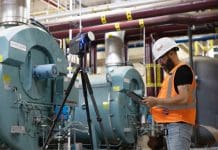As the construction industry continues moving towards a more sustainable future, tracking the amount of carbon embedded in building products will be crucial to companies becoming more environmentally friendly. Andrew Stolworthy, Director of Product and Market Development of SFS, explains what the industry needs to do on this journey
Sustainability has never been more important and key to this challenge is in making the right choice of products to use. This is particularly acute when it comes to the amount of embodied carbon in building products.
What is embodied carbon?
Embodied carbon refers to all the carbon produced during the product’s life. This isn’t always easy to determine – much of the carbon you can’t see is locked in infrastructure, buildings and products. The embodied carbon of these items come from more than just the materials used to build them.
For example, when calculating embodied carbon, we must measure the carbon output of the entire manufacturing process. Carbon emissions from the production of raw materials are part of the equation, as are those from shipping and transportation. Even assembling the parts into a finished product contributes to that product’s carbon footprint in some cases.
Embedded emissions in the built environment
A significant portion of greenhouse gas (GHG) emissions is made up of embodied carbon and is therefore one of the fundamental challenges for the construction industry in its move towards sustainability.
These GHG emissions from the built environment can be divided into two categories: operational carbon – attributed to operational energy consumption during the building’s lifetime – and embodied carbon. Approximately 40% of energy-related GHG emissions are driven by generating buildings, while 11% is generated from manufacturing materials, according to the Carbon Leadership Forum.
Identifying embodied carbon
As we begin to see more architects, specifiers and contractors concerned with the carbon emissions of each product, the question becomes: how can the carbon footprints of products be effectively defined to include accurate information on embodied carbon?
One method is environmental product declarations (EPDs), which have become a growing source of environmental data. These are increasingly being used in assessing buildings’ environmental performance and in comparing products for procurement decisions later on in the construction process.
However, a lack of data quality and the lack of transparency of EPDs means identifying and purchasing low-embodied carbon products can be challenging.
Currently, the UK has no formal regulation regarding embodied carbon emissions. The campaign group ACAN (Architects Climate Action Network) is demanding the introduction of regulatory legislation in line with countries such as France, Finland and the Netherlands.
Likewise, Part Z – a group comprising architects, structural engineers and sustainability experts – is proposing a new section to be added to the Building Regulations requiring compulsory whole-life carbon assessments.
Ensuring EPDs are verified and compliant
However, with such game-changing action and initiative, alterations to standards and regulations will inevitably take to come into force. Until then, it is vital architects and specifiers understand the carbon footprint of the products they choose.
Manufacturers must attain verified environmental product declarations (EPDs) and confirm that their products comply with European standard EN 15804. This standard describes the technical performance of the product through its lifecycle.
Having a verified EPD means that architects and specifiers can better trust the origin of a product so the amount of embodied carbon within it can be easily quantifiable.
This provides independent proof of the product’s sustainability, supporting compliance with Part L of the Building Regulations. For the manufacturer, there is the clear benefit of the product being recognised as fit-for-purpose from a sustainability perspective, helping them meet customer demands and specifications.
Leading the market towards sustainability
It is for all these reasons that SFS has signed up to the BRE’s EPD scheme.
Among a host of key benefits, SFS has begun implementing the BRE’s online measuring tool, LINA, which gives access to best-in-class EPD methodology. This ensures a scientific basis behind the calculations of embodied carbon, bringing transparency back into the supply chain, as well as driving product innovation making more sustainable choices. We are currently in the process of getting our NVELOPE® subframe systems verified and will then roll out to other SFS products.
EPDs are but one of several measures SFS has adopted to help customers make more informed choices about sustainability. To support the principle of capping embodied carbon emissions on all major construction projects through the introduction of Approved Documentation, SFS are now active members of the UN Global Compact.
Alongside this, SFS is at the forefront of digital construction with tools including the NVELOPE® Project Builder service for rainscreen subframes systems, an online tool available to building architects and specifiers that calculates all necessary considerations in a project’s initial planning stage. It allows for automated calculations of general building areas and provides all component guides and list prices, NBS specifications and 3D modelling of thermal point loss areas.
This is in addition to SFS’ Thermal Lite tool, which calculates U-values, identifies sources of thermal bridging and offers tailored guidance on reducing thermal performance gaps due to cold bridging.
These tools are all available through SFS’ ConnectSuiteÒ, an online portal that hosts smart tools and apps to streamline specification and design processes.
Measuring embodied carbon is just the first step
Regardless of legislative change, the benefits of knowing how much embodied carbon there is in building products should be obvious.
Whether by helping those architects and specifiers to make more informed choices today or by challenging ourselves to think differently about how we source, manufacture and transport products, we’re excited by the possibilities.
Tracking embodied carbon is just the start – we are already on the pathway to other digital technologies such as BIM digital twin capabilities and we are actively engaging with industry bodies such as Construction Excellence and joined initiatives such as the Construction Innovation Hub Platform Project, working to identify, refine and develop solutions that can be deployed to make positive change in terms of sustainable construction.
At SFS, we believe in securing futures and this scheme helps us in that goal. After all, building plans of today are tomorrow’s homes, offices, shops, hotels and hospitals. To secure those buildings and their futures, the work begins now.
*Please Note: This is a commercial profile.
Bethany Haller, Wyatt International
bethany@wyattinternational.com
Tel: 0121 454 8181
Vincent Matthews, SFS
Tel: 0330 0555 888














